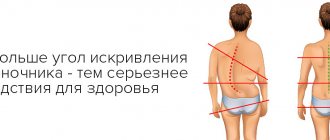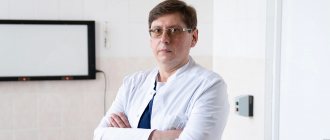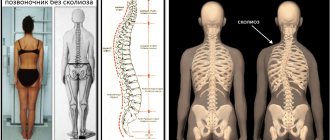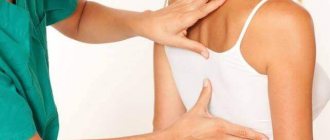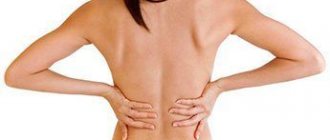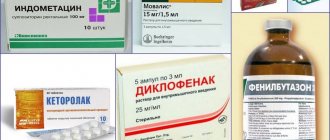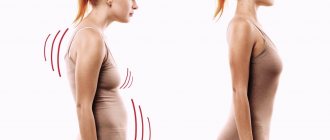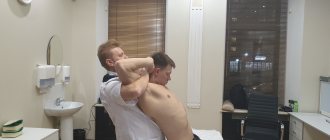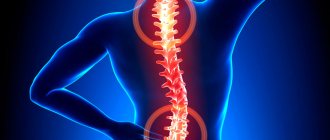Many people face a disease called S-shaped scoliosis. This is one of the types of spinal pathologies. Often such deformation is observed in girls of school age. Scoliosis appears due to incorrect body position during lessons. As children spend more time in classes, the risk of developing the disease increases.
The danger of the disease lies in the fact that if it is not treated, it will become severe, followed by surgical intervention.
Center for Neurosurgery Dr. Baklanov A.N. successfully deals with surgical and conservative treatment of spinal scoliosis in children. We will answer all your questions by phone. You can also ask a question by filling out the request form below.
What it is
The word "scoliosis" translated from Greek means "crooked" . In most cases, it first appears in a child between the ages of ten and fifteen years. The greatest danger when developing in preschoolers is that between the ages of 4 and 7 years there is a possibility of its rapid progression.
This disease is characterized by damage to the musculoskeletal system, in which, in addition to the curvature of the entire column in the lateral plane, the vertebrae also rotate . As a rule, this happens in cases where the back is in an incorrect position for a long time.
Spinal deformity poses a risk of developing pathologies in the functioning of internal organs, especially those located in the chest area. In addition, soon her external signs also become noticeable.
They are easily distinguished by the presence of asymmetrical changes, which include not only curves of the spine, but also an abnormal position of the scapula or ribs that protrude more on one side than the other. At the same time, the tone of the surrounding muscles differs significantly.
Scoliosis, which has an S-shape, simultaneously affects two parts of the spinal column - thoracic and lumbar . As a rule, the appearance of a thoracic curve inevitably follows a curvature in the lumbar region. It can be determined by the presence of the first arch in the area of 8-10 vertebrae, and the second in the area of 1-3 vertebrae.
In S-shaped scoliosis, the thoracic and lumbar spine are affected simultaneously
Brief history of the disease
S-shaped scoliosis, or also called combined (based on the nature of the location of the curvatures), is classified as a rapidly progressive pathology. Due to uneven loads, spasms of the back muscles lead to the formation of a stable misalignment of the spinal column.
The beginning of the pathology is the appearance of the first bend in the thoracic region, approximately 7-8 vertebrae. If the apex of the bend is located higher, it poses a risk of increased risk of complications. Gradually, a second bend begins to appear in the area of 1-2 lumbar vertebrae.
The two arcs have a negative impact on each other. They lead to a shift in the center of gravity and a general noticeable deterioration in the patient’s condition.
Classification and degrees
The classification of scoliosis can vary depending on factors.
According to the duration of development and the period of onset of pathology, it can be:
- congenital, in which the incorrect position of the spinal column was formed even before the birth of the child. Often accompanied by hip dislocation, clubfoot, and disruptions in the functioning of the pelvic organs;
- children's if the patient's age is from 0 to 10 years. The health hazard in this case is due to the fact that spinal deformities can provoke irreversible pathologies in the developing child’s body;
- adolescent, the most common, associated with the developmental period from 10 to 15 years. Its causes are incorrect posture, especially when sitting for a long time at a table or desk;
- adults, the most rare, usually diagnosed in the absence of treatment measures at an earlier age.
Scoliosis can be muscular - it develops due to poor development of the back muscles. According to the origin and reasons for its appearance, scoliosis is distinguished:
- muscular, which occurs with poor development of muscles and ligaments that no longer provide the correct shape of the spine due to the development of, for example, rickets;
- neurogenic in nature, when scoliosis develops after illnesses such as polio, spastic paralysis;
- congenital, appearing when bone tissue develops incorrectly due to pathologies in the chest, burns or plastic surgery.
Scoliosis, which is an acquired pathology, is divided into the following types:
- idiopathic;
- rachitic;
- habitual;
- paralytic;
- reflex pain;
- static.
The most convenient for medical practice is a classification that takes into account the degree of development of scoliosis:
| 1st degree | characterized by distortion of the waist, shoulders and pelvis, in which the angle of inclination does not exceed 10 degrees |
| 2nd degree | characterized by an inclination angle of 10-25 degrees, pronounced spinal deformities, and the presence of compensatory arches |
| 3rd degree | can be recognized by the angle of inclination from 20 to 50 degrees, the presence of pronounced and persistent deformation of the chest |
| 4th degree | the angle exceeds 50 degrees, leads to the appearance of a rib hump and skewed shoulders, the torso takes on disfigured shapes |
Prevalence and significance
Currently, S-shaped scoliosis is one of the leading diseases worldwide due to the prevalence of a sedentary lifestyle. According to paleontology and biology, scoliosis is a consequence of upright posture acquired by humans in the process of evolution. In general, all back pathologies are caused by changes in external influences on the human body for which the spine is not prepared.
Often people neglect preventive and therapeutic measures in relation to this disease, which causes its progression and the development of side symptoms.
If completely ignored, scoliosis can lead to painful sensations that cause great discomfort for a person. This attitude is a grave mistake, since it is much easier to prevent the appearance of scoliosis in the early stages than to treat its negative consequences.
Risk factors and causes
Scoliosis can appear in a person of any age, including in completely healthy people.
This pathology can be caused by the negative impact of the following factors::
- regular non-compliance with doctors’ recommendations regarding correct posture and requirements for organizing the workplace;
- low level of physical activity;
- the presence of problems with connective tissue;
- carrying heavy objects.
The reasons for the appearance of curvatures in the spine can also be different.
Wrong lifestyle , in particular, staying in one position for a long time. This position is undesirable for the spine and in case of incorrect posture, the uncomfortable posture is assumed due to the elasticity of the bones, especially in childhood. In this case, the s-shaped curvature is a consequence of compensation processes, which is doubly dangerous. Compensatory curvature appears higher than the primary one. Thus, curvature in the lumbar area necessarily causes the appearance of curvature at chest level. This poses a serious health threat because it causes curvature of the ribs, as well as the heart and lungs.
Excess body weight , which creates additional pressure on the spine. The type of obesity is important. The pear-shaped type puts more pressure on the lower back, while the apple-shaped type puts more pressure on the chest and neck. Most often, obesity accompanies a sedentary lifestyle and becomes its consequence.
Changes in the muscle tone of the corset . In this case, scoliosis develops as a consequence of powerlifting, especially with an incorrectly structured training regimen that puts a large load on the same muscle groups. As a result, the muscle corset is destroyed and the spine gradually warps. Lifting weights makes the situation worse.
Serious injuries and fractures cause curvature of the spine in all cases. If a person does not wear a corset, then the curvature will only increase due to damage and muscle atrophy, especially if the person goes through a long rehabilitation period.
Consequences
Due to the curvature of the spine, the ribs begin to deform, which leads to improper functioning of the internal organs. In the absence of therapeutic measures, the deformation of the spinal column begins to intensify and gradually leads to displacement of the ribs .
Then the work of the heart and lungs becomes impaired. Over time, complications only intensify. Due to the increasing load, a person experiences shortness of breath. The pressure gradually increases and the pulse quickens. In these cases, reducing blood pressure using drugs is almost impossible.
An advanced form of scoliosis causes the development of ischemia . Sometimes neurological abnormalities, noticeable by muscle twitching, are accompanied by loss of sensitivity in certain areas of the skin. There may even be loss of vision.
Curvature of the spinal column in the lumbar region provokes pinched nerve endings , malfunctioning of the gastrointestinal tract, reproductive and urinary systems. Most often, patients begin to complain of weakness of the abdominal muscles, flatulence, swelling in the legs, and constipation.
The most dangerous complication is spinal cord compression , which can result in paralysis of the lower extremities. All changes may be accompanied by disturbances in the patient’s psychological state.
Causes of S-shaped scoliosis
Most often, this disease progresses in adolescence, during a period of rapid development. At the same time, the disease is considered to be idiopathic, that is, the exact cause of its occurrence is almost impossible to establish. However, nevertheless, there are a number of factors that can give impetus to the development of this spinal disease:
- Sedentary lifestyle
- Being overweight
- Hereditary predisposition
- Playing asymmetrical sports (tennis, shot throw, etc.)
- Having other spinal problems
Symptoms and diagnostic methods
Did you know that...
Next fact
S-shaped scoliosis can be distinguished in the second stage of the disease by the following signs:
- vertebral rotation;
- changed neck contour;
- changed position of the pelvis.
Irregularities on the back are also visually noticeable:
- protrusion of muscles in the thoracic region;
- depression in the lumbar area.
At the third stage, neurological symptoms appear due to pinched nerve endings. This leads to pain with any body movement.
You should also be wary if you have the following signs::
- slouch;
- shoulder asymmetry;
- back pain after prolonged walking or standing.
If there is any suspicion of scoliosis, an examination by an orthopedist is required. During the examination, the doctor checks the evenness of the back and asks you to touch the floor with your fingers, checking the symmetry of the shoulder blades. After this, the doctor prescribes an x-ray, and also, if necessary, a CT or MRI.
Video: “Can scoliosis be cured?”
Treatment
Treatment of scoliosis is also prescribed by an orthopedist. In the absence of such a specialist, assistance can be provided by a surgeon or traumatologist.
The main goal of treatment is to stop the progression of the pathology. following methods can be used :
- massage;
- manual therapy;
- physiotherapy;
- acupuncture;
- physiotherapy.
Drugs
Medications are not used in the treatment of scoliosis, because can't fix his situation .
Surgery
In especially severe cases, when the position of the spine becomes critical, surgical intervention may be prescribed.
Exercise therapy and massage
Particular attention should be paid to physical therapy - the main method of treating grade 1 and 2 scoliosis. The greatest result in the treatment of grade 1 and 2 scoliosis is achieved by physical therapy, with which you can practically straighten the spine.
At subsequent stages, it becomes impossible to achieve a positive effect.
Special exercises for scoliosis can be easily found.
It is important to remember that all of them must be performed with minimal stress.
A set of exercises is usually selected for each patient strictly according to individual indicators.
Massage and physiotherapy procedures will help consolidate the therapeutic result.
Massage for scoliosis is very important and will help:
- carrying out reflex stimulation of internal organs;
- reducing pain in the back;
- improving blood and lymph circulation of the spine;
- normalization of the condition of the back muscle corset.
Treatment at home or with folk remedies
Compresses that soothe pain will help alleviate the patient’s condition at home : with the use of salt - you need to dissolve 25 g of ordinary or sea salt in a glass of boiling water and apply a moistened bandage to the sore spot; Mix crushed aloe leaves with 100 g of honey and half a glass of vodka, moisten a cotton cloth with the mixed ingredients and leave the compress overnight.
Pine baths, in which pine branches are placed, also promote healing.
Video: “Exercises for scoliosis”
Exercises for S-shaped scoliosis
Daily exercise is the key to a healthy back. A few simple exercises and activities will allow you to forget about spinal problems forever:
- Lying on your stomach, lean on your bent arm. Raise your other arm and opposite leg as far as possible, holding them for a few seconds. Repeat the exercise on the other side.
- From the same position, lift all limbs up at the same time. Hold, lower.
- Swimming in the pool will be very useful.
It is not recommended to do the exercises without consulting your doctor. Only he, knowing the characteristics of your body, will be able to select an individual course of therapeutic exercises.
